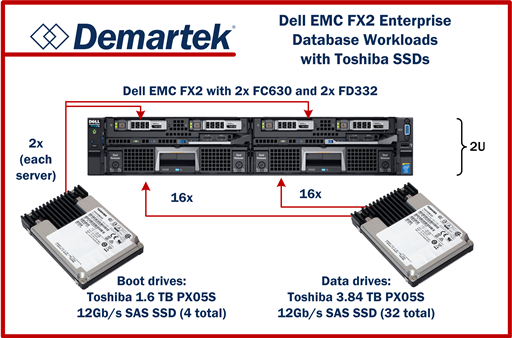Demartek Evaluation: Dell EMC FX2 Enterprise Database Workloads with Toshiba SSDs
September 2017
The Dell EMC PowerEdge FX2 enclosure is a 2U hybrid rack mount computing platform that combines the flexibility, density, and efficiencies of blade server technology with the simplicity and cost benefits of rack-based systems. The FX architecture’s innovative modular design supports IT resource building blocks of varying sizes so data centers have greater flexibility to construct their infrastructures. The enclosure uses Toshiba’s 12Gb/s SAS SSDs to provide performance and density to the solution. This platform can be attractive to those needing more computing power in a smaller space without having to go through the “learning curve” of blade environments.
We wanted to show a real-world example of the density and simplicity of the FX architecture by deploying an Oracle database solution. For this particular set of tests, we chose two compute nodes and two storage nodes. For the compute nodes, we chose the half-width PowerEdge FC630, a two-socket workhorse server that provides a powerful punch in a small footprint. For the storage nodes, we chose the half-width PowerEdge FD332. These dense storage nodes support 16 small form factor devices – and we filled them with 3.84TB Toshiba PX05S Series 12Gb/s SAS SSDs, providing more than 60 terabytes of flash storage in each storage node. We then assigned one storage node to each compute node.
We deployed the latest version of the Oracle database on both compute nodes, each having its own all-flash storage node. We ran an OLTP workload on both compute nodes to see what kind of performance we could get in a 2U rack space.

|


 We are pleased to announce that Principled Technologies has acquired Demartek.
We are pleased to announce that Principled Technologies has acquired Demartek.


